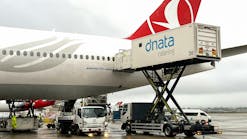Four Keys for Beginning and Maintaining a Staffing Agency Relationship
The need for flexible and scalable workforce, especially in the unpredictable roller-coaster of our industry, is more important than ever.
Demand and flexibility is the most critical component for moving air cargo. Over the past several years, I have provided staffing services for several of the top 20 ground handling agents (GHAs), fixed based operators (FBOs), air carriers, freight forwarders and in large warehouse facilities surrounding the airport.
I have been supporting staffing services for customers at key air cargo hubs and there are several keys for success in choosing the “right” supplier for staffing agency labor.
Need
Most companies have a need. Usually it is on third shift positions, finding experienced fork lift drivers, cargo agents, office agents, dock or even ramp personnel.
This increases during the busy season, typically at the end of Q2 through Q4 until the Chinese New Year. Supervisors and operations managers know what shifts and positions are lagging and where the internal HR department may need some assistance or an outside company to partner with to fill the gaps.
This assistance can come from an outside labor supplier staffing agency. The staffing agency is the basic component of most successful GHAs. The staffing agency acts as an extension of your internal HR team. The staffing agency is given the directive of types and number of open positions per shift and authority to fill those “open lines” with qualified SIDA (security identification display area) or STA (security threat assessment) cleared employees.
As a best practice, work with your team to gather all the “open lines” needs from the supervisors, operations manager and HR. Once completed, have the staffing agency create an excel sheet with time and position types. Partner with the staffing agency and set the expectation with the supervisors that each open line will be filled in with a name and start date of qualified employees over the next few weeks. Set the exchange of information with the staffing agency to share and report number of “starts” weekly. Most of the information will flow though the director of operations, supervisors, HR and, in some cases, the general manager.
A useful tip to consider is opening all the open position lines and be competitive with the GHA’s internal HR recruiting team to fill the open lines/positions. Open more positions then you need to account for normal attrition rates. If your internal HR team is confident they can fill first shift, then close those roles to the staffing agency. Let the agency focus on second and third shifts, weekends and more challenging roles to make the best use of the associated cost.
Qualifying the Labor Supplier
Does the labor supplier in your area support any customers at the airport? Does that labor supplier support other airports?
In most cases, there are only a few staffing companies that are registered to issue badges at the airport. Many companies are not and, in turn, will not understand your specific needs. A company that has staffing experience off the airfield at a warehouse or nearby manufacturing facility, but no experience at the airport, will not have the knowledge or resources to understand the complexities of contracting, letter of intent submittal, bonding, customs, mandatory training, SIDA badging, STA clearance or staffing requirements for mail handling agents.
A best practice is to find a company that can support your company and badge employees. After finding a staffing company that is qualified to work at the airport, ask how many badged employees they have out on assignments and what GHAs they have or currently service. Leverage this data; many times, if a staffing organization has several customers in the area, chances are they know your competition better then you do. Ask some questions. While the staffing company cannot violate NDAs (non-disclosure agreements), they will be able to provide an idea and data regarding competitive pay rates, ideal shift differentials, talent retention plans, benefits and best employee appreciation practices to retain talent.
A tip for ground handlers and support staff, we are all in a tight-knit community so ask around about what staffing agency is being utilized and how their experience has been. Stop by the badging office to see what posters for hiring are on the board and who the local agencies are.
Forecasting
Plan ahead for the year. This can be difficult as flights get canceled, contracts come and go, airlines take their business to the competitors, or your operation gains new customers. But we all know from our supervisors and operations managers what shifts are short and the estimated tonnage per employees, per hour to be moved, and how many employees it takes to move that tonnage.
Once forecasting is complete, start the agency small and very early from when you need them to perform and fill many open lines. Place an order of 10-15 employees just to have the operational flow and expectations of the expected performance set. Afterwards, you can build operations correctly to rely on the agency when you need 60-80 or 100+ open positions.
As a best practice as a staffing agency representative, I always urge customers to look ahead for upcoming labor demand due to the long lag time of badging and starting employees. The typical time to have an employee from their application, to offer accepted, to badging as well as drug and background screening completed, is approximately 10 business days. This is a two-week process to start a SIDA badged or even STA cleared employee. Also allow time for attrition. The typical two week time frame to start work for the employee at most companies affects a 40-50 percent attrition rate before training even begins.
A tip to consider is asking the staffing agency to provide weekly onboarding logs and plan that 40 percent will not complete the process due to drug and background screens.
Workforce Flexibility
If you are a large or midsized GHA/FBO, you need a staffing supplier who has a presence or an office, even if it happens to be at another GHA/FBO at the airport. This flexibility allows the partnership with the labor supplier to scale with your staffing needs. It also helps both customer and staffing supplier to collect badges, scale up and down quickly, manage workforce, collect, submit and approve timecards as well as understand the warehouse supervisor’s needs.
The VOP (vendor on premise)/onsite provides the distinct advantage for both GHA/FBO and the staffing agency partner effectively. This onsite partnership reduces turnover and allows for the direct managing of the employees provided by the agency. In the staffing business, human contact/management/oversight between staffing agency and employees is essential to retention. Many times, the agency will have office hours at the GHA’s warehouse to workout timecard issues, sick time, worker’s comp, training, security, changing of employee schedules, badging issues and more.
A best practice, if the staffing order is 20 or more employees, it would be suggested that you arrange interviews and begin the onboarding process at your location twice a week or, in some cases, every day until the number of employees requested is fulfilled. Allow the agency to have an office space available and printer access to have candidates onboarded directly at your site. Whenever 50 or more employees are needed by the agency, it is a best to establish a VOP/onsite operation until the need is completed.
When employees have been successfully onboarded, keep in mind that each staffing contract will contain a clause regarding a number of hours or days on assignment that an employee can be transferred over to the GHA’s/employer’s payroll for a small fee or with zero fee conversion terms. Use this to your advantage and partner with the supervisors and staffing agency on who should be and should not be offered a permanent position directly with the GHA/FBO. Use this to retain your talent pipeline with hires from the agency. Some of the best employees and supervisors at a GHA came in as temporary labor employees who were promoted and then hired on for permanent roles.
A Tip on VOP. If the staffing ramp is over 45-50+ total employees, the staffing company should have office space. This assures that recruiting, retention, timekeeping workforce management of the staffing companies’ employees is completed. This also creates a dedicated team for interviewing, recruiting, and overall management.
Follow these four keys and tips when beginning and maintaining the staffing agency relationship. Keep in mind that the staffing agency is hired not as a product but as a resource. Treat them as a part of your operation and form a partnership so that when needs arise, you can scale with a trusted partner.
Rich Geller is a director of business development and provides staffing services to airlines, GHAs, FBOs, passenger service providers, and freight forwarders. He can be reached at www.linkedin.com/in/richgeller7.




